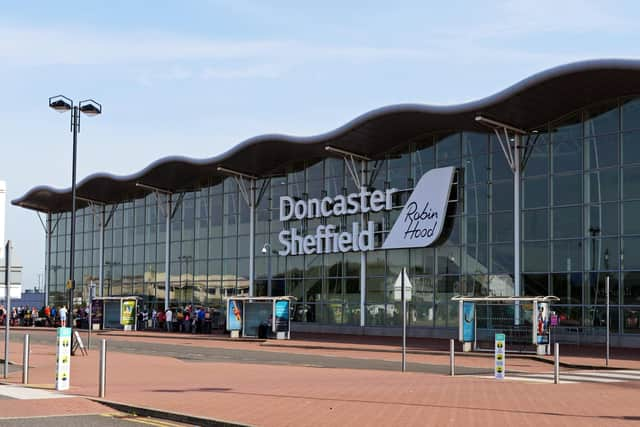What Doncaster Sheffield Airport's closure will mean for local property prices
Before the pandemic, South Yorkshire’s only airport, which opened on the site of the former RAF Finningley airbase in 2005, welcomed almost 1.5m passengers every year. But Peel Group launched a review into its future after budget airline Wizz Air pulled out in July.
And now, despite the promise of new Prime Minister Liz Truss to protect ‘DSA’, the skies above Bawtry, Austerfield and Misterton (the latter just over the South Yorkshire border in Nottinghamshire), some of the priciest residential locations in Doncaster, will fall silent.
Advertisement
Hide AdAdvertisement
Hide Ad“The most expensive areas to live in Doncaster are the DN9 and DN10 postcodes which interestingly are the closest in proximity to DSA,” says Sam Hunter, co-founder and chief operating officer at leading property data and insight platform, Homesearch, https://homesearch.co.uk/.


“The DN10 postcode, which includes areas such as Bawtry and Misterton, is the most expensive place to live in Doncaster, boasting average [sold] house prices of £291,995. The DN9 postcode, which also includes the airport within its boundaries and areas such as Epworth and Finningley, is slightly cheaper with average prices of £267,925.”
Katie Spink, residential sales manager at estate agents Fine & Country in Bawtry, says that she likes working in such “a vibrant market town”, dominated by fine Georgian buildings dating from centuries before air travel, when Bawtry was on the London stagecoach route to the North.
“Bawtry proves ever popular for a wide age range of buyers,” Spink points out. “Excellent amenities on the doorstep combined with a thriving nightlife means it continues to be a hotspot whilst being extremely commutable – the A1 is nearby. A buyer looking for a more rural lifestyle may suit a number of villages to the south of Bawtry including Everton and Clayworth, with their country walks and cosy pubs.”
Advertisement
Hide AdAdvertisement
Hide AdWill the airport’s passing make the surrounding area even more desirable, or have a detrimental effect, as those who worked there, or travelled regularly might have chosen to live within easy distance?
“The only small crumb of comfort is the potential in the long term for house prices to gradually increase, especially those directly under the existing flight path where concerns about air and noise pollution can put certain buyers off,” says Hunter. “Although given how strong prices have been in the DN9 and DN10 postcodes in recent years, this doesn’t look to have been the case for many.”
Meanwhile, just seven miles away in Doncaster city centre - the town achieved city status as part of the late Queen’s Platinum Jubilee Civic Honours, and will receive its Letters Patent on November 11 - the central DN1 postcode is the cheapest place to live with sold prices averaging £103,572.
According to Solomon Investment Partners, whose three most recent local developments, converted office blocks, have all sold out, DN1 is still a fantastic investment opportunity, despite the recent bad news.
Advertisement
Hide AdAdvertisement
Hide Ad“Prices in DN1 and indeed across the wider reaches of Doncaster remain very affordable and rental demand is buoyant,” says Andrew Ward, managing director. “With millions now being spent on infrastructure and regeneration, the prospects for capital appreciation here are excellent. We’re actively looking for new development opportunities.”
Like many locations once dominated by heavy industry, Doncaster, a major centre for railways, engineering and coal, experiences huge disparities from one end of the residential market to the other.
However, despite the housing market plateauing slightly here over the last few months, due to cost-of-living concerns and inflation, average overall property prices have experienced an 11 per cent increase since 2019, according to Homesearch. The company says average sale prices were £159,606 two years ago, and today are £177,310. As a counterweight, average asking prices leapt to £203,296 in March this year, before recently cooling slightly to £200,454.
“Doncaster has seen a very buoyant property market over the last 18 months but with rising inflation and financial uncertainty properties are not selling at the speed they have been,” says Spink. “There is plenty of fresh stock coming to the market but buyers are becoming ever more wary of where they invest their money.”
Advertisement
Hide AdAdvertisement
Hide AdHunter believes that it’s inevitable that the housing and rental market will be impacted by the sudden loss of hundreds of jobs when DSA closes.
Although there has been a huge outcry, and calls for the government to justify how closure sits with the trumpeted Conservative policy of ‘levelling up’, the publicity surrounding DSA has had one positive outcome - at least people outside the region can now place Doncaster on a map.
“Slowly over the last two years an influx of huge international companies has started to invest in Doncaster including the likes of Amazon and Great Bear for warehousing and distribution,” says Spink. “We only hope that through these positive steps people and businesses will become ever more aware of what Doncaster and the surrounding areas have to offer.”